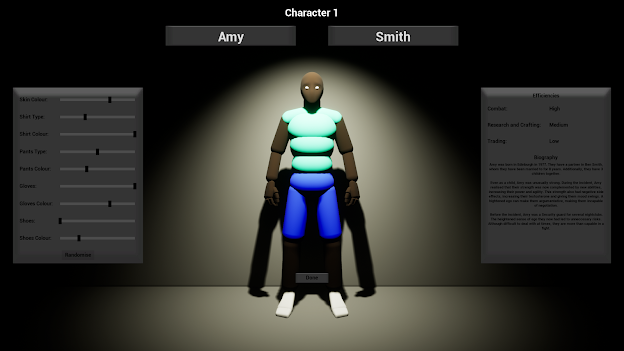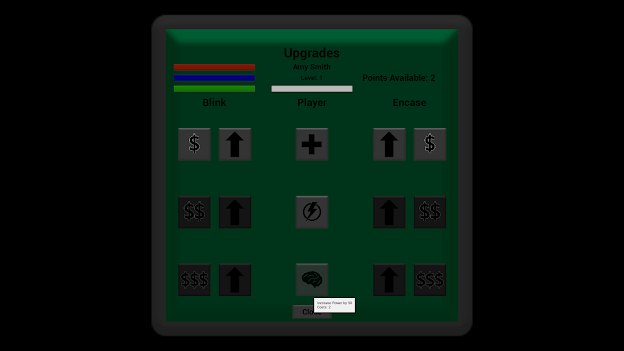Project X Submission Update Part One
Project X Submission Update
Part One: Mechanics Breakdown
During the course of this project, I have aimed to create a playable experience, which would allow me, as a developer, to experiment with mechanics, both new and pre-existing, for the purposes of creating relatable, attachable characters. Character attachment in games is a subject which has been been the subject of many reviews, so to improve my understanding of mechanics designed to nourish character attachments, I decided early on that I would create a character-centric experience which would allow players to create and develop their characters over the course of their playthrough. The intended effect of this experience was to try and create a relationship between the player and their characters. To do this effectively, I had to choose a selection of mechanics which would allow me to explore a variety of approaches to this topic.
In the following post, I will break down the mechanics I chose to focus on, exploring how they were effective in their purpose, as well as looking at how they could be improved, whilst comparing them to existing information on the subject. Following this, I will breakdown my missions and level designs, in order to offer a good overview of the developments I have made.
To begin with, I will talk about the final product and its properties, in order to give an initial impression of what these mechanics have been combined into. Throughout the year, I have created an experience which is between 45 minutes to an hour-long and allows players to create three unique characters, whom they will use to complete a total of 4 story missions, with the potential for further missions to be generated based on the events of the player's playthrough. The overall playtime of this project was an incredibly important aspect of this development process, as the effectiveness of subsequent mechanics could be drastically affected by the player's ability to spend time with their characters. According to the 'Mere Exposure Effect', the more an audience is exposed to a character, the more likely they are to develop an emotional attachment to a character. Therefore, by having a playtime around the one hour mark, I feel players are given sufficient opportunity to learn and develop their characters, allowing the other mechanics in this experience to be as effective as possible.
Character Creation System
At the beginning of this experience, the player is given the opportunity to create their characters. Amongst the choices the player has in this character creation phase are the appearance and name of their character. Although a simple system, the characters created conform to the low poly art style of the overall experience. Additionally, although options could be considered limited, there are approximately 860'000 possible variations of character appearance, allowing this system to create unique, varied characters.
Additionally, during this creation phase, the characters are assigned their archetypes. These are the individual personalities of each character, determining their individual efficiencies, as well as their background and stats. In each playthrough, the player is given 3 unique characters;
- The first is most efficient in combat and is assigned a background in manually intensive careers, such as the Armed Forces or Professional Sport. This character is given a family life consisting of a partner and at least one child, as well as increased Health and Stamina, to make them more efficient in firefights. Furthermore, this character is given two abilities, Blink and Encased.
- The second is most efficient in crafting and is assigned a background in intellectually intensive careers, such as in medicine and Science. This character is always given a partner but never children meaning they will only refer to their partner in their family life. This character also receives two abilities, Slow Time and Cloak.
- The third is most efficient in trading and is assigned a background in which they have used their natural charisma. Equally, this character always has a partner and at least one child. They receive he abilities Stun and Death Rattle.
The occupations and family lives of these characters are generated randomly ensuring characters are unique in every playthrough, without affecting the balance of the players game. This is important, as the characters are balanced to complement each other and physical changes to their behaviour outside of background generation may affect the player's playthrough. This mechanic is effective, as it enables the player to have control over their characters from the beginning, increasing the likelihood that a relationship will be formed between the player and their characters.
Crafting system
In my project, the player is able to craft weapons using their characters and the extremely simple crafting system. Whilst on missions, the player will come across blueprints for specific weapons. By collecting these blueprints, the player is able to gain access to new crafting options. To craft the weapons, the player simply pays the set price for the item. However, the price they pay is dependant on which characters the player has available to them. Their crafting efficient character is able to pay the least to access the weapons in this system, whilst the combat and trading efficient characters are forced to pay more, as well as be limited to what they can craft. This system enables me to showcase an aspect of each character's strengths and weaknesses. This is important, as my peer review sessions during the early stages of this project highlighted how character attachment mechanics are most effective when the characters attributes, strengths and weaknesses are shown, as well as explained.
Character Profiles
Throughout the duration of the playthrough, much of the character development will be performed from the character profile screen.
From here, the player is able to customise their characters inventories and equipment, as well as assign them money and ammunition to take on missions. Additionally, the player can upgrade their character's attributes and abilities, as well as view their background and relationships. Enabling the player to view their character background gives them the opportunity to get to know their character better, allowing them to emphasise with their character more clearly. Additionally, by giving the player extensive control over their character's inventory, the player is able to adapt and develop their characters efficiencies on a more personal level, by controlling their effectiveness in combat situations with different loadouts.
From here, the player is able to customise their characters inventories and equipment, as well as assign them money and ammunition to take on missions. Additionally, the player can upgrade their character's attributes and abilities, as well as view their background and relationships. Enabling the player to view their character background gives them the opportunity to get to know their character better, allowing them to emphasise with their character more clearly. Additionally, by giving the player extensive control over their character's inventory, the player is able to adapt and develop their characters efficiencies on a more personal level, by controlling their effectiveness in combat situations with different loadouts.
Weapon Customisation
An additional layer of control is also given to players with the ability to customise weapon attachments. By allowing the player the option of adding attachments, their ability to control the characters handling and combat efficiency is further increased. This incredible scale of control allows the player to have a higher sense of ownership over their characters actions, which is vital to the development of a relationship between the player and their character.
In total, there are 60 weapons in this experience. By giving the player such a large variety of weapons, I ensure that each player is able to use at least one weapon which they are familiar with. Additionally, with the inclusion of the aforementioned crafting system, the large variety is able to offer the player a tangible sense of progression.
Mission Briefings and Characters Interactions
To start the mission gameplay in this experience, the player begins by entering the player briefing. This stage allows the player to see the story behind the upcoming mission as well as view the recommended character for the mission. In total, there are 4 story missions to play, which ask the player to complete objectives such as eliminate an enemy colonel or retrieve intel.
Each mission has its own player briefings, allowing each mission to have its own recommended character. After the player feels comfortable that they understand the upcoming mission, they may move on the character interaction phase. During this phase, the player is able to interact with their characters and discuss the upcoming mission, in order to find out from the characters themselves who is interested in taking the mission on. In total, there are 55 conversations to be seen in this playthrough. Should the player complete the game flawlessly, they will only see 4 of these conversations during their playthrough. However, as characters become unavailable, the conversations had will begin to change to accommodate for the unavailable character's absence. This is a crucial stage in my experience, as it enables the player to interact with their characters and witness how their characters treat the player and their fellow characters. This is a vital step in the development of a character, as being able to see this interaction gives the player another element of the character's personality
to emphasise with.
to emphasise with.
Gameplay
Gameplay in this experience is designed to be unforgiving and realistic. Players learn quickly to adapt to combat situations and scout out routes of movement in order to avoid unnecessary risks. Played from a 3rd person perspective, the player is also given the opportunity to see the character they created and also pick up on very subtle differences in each character handling and physical stance. The combat character, for example, moves much more fluidly and holds his weapons with confidence and style, whilst the crafting character is more sluggish and visibly uncomfortable with their weapons. These subtle changes are another way for me to indicate the characters efficiencies physically, which is an important feature to have in order to create relatable and attachable characters.
The weapons in this experience are also realistic. With multiple fire rates, recoil, weapon-specific range differences and unique ammunition capacities and reload speeds, each weapon is effective in different areas, meaning the player has to be on their toes to get the most out of their weapons.
Using and Upgrading Abilities








Comments
Post a Comment